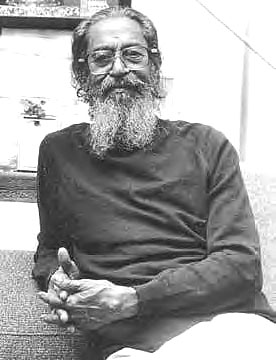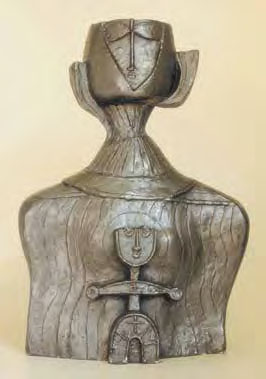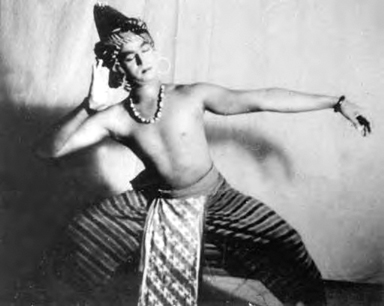Registered with the Registrar of Newspapers for India under R.N.I 53640/91
Vol. XXIX No. 16, December 1-15, 2019
Artiste and artist – The story of Dhanapal
by V. Karpagalakshmi

Rarely do we come across a visual artist who is also a performing artist. S. Dhanapal, whose centenary is being celebrated this year, was an exception. In addition to being an acclaimed sculptor with several outstanding creations to his credit as well as a painter, he also made a mark as a Bharatanatyam dancer.
He was born on March 3, 1919 in a house in Mylapore, Chennai. His only outing as a child was to the Kapaleeswara temple nearby, where he would watch with fascination as the artisans made vahanas for the deities. This, and the wooden dolls his friend’s father used to make, kindled the artist in him.
 Dhanapal’s sculpture: Mother and child
Dhanapal’s sculpture: Mother and child On observing his skilful drawings, his school teacher suggested that he join the Government School of Arts and Crafts. Dhanapal did so and came under the tutelage of the principal, well-known sculptor Debi Prasad Roy Choudhury, and K.C.S. Panicker. He would go on to become a renowned sculptor and painter of the modern art movement of Madras, recognised as a legend in the field.
Besides fine arts, Dhanapal was interested in music and dance. Learning music was out of the question for the boy, but he would sit near his sisters attentively while they learnt music at home and could sing varnams. In those days there were no tape recorders, only gramophones; listening to records, even if they were devotional songs, was not allowed. Where then was the question of getting money to attend music concerts? So whenever he and his friends wanted to attend Ariyakudi Ramanuja Iyengar’s concert, they would paint banners during the night and earn four annas besides refreshments. As art students it was easy for them to get such jobs, and working for four to five nights would fetch them enough money to buy tickets to attend the concert.
It was not just Carnatic music. Dhanapal was also drawn to the world of dance after watching the performance of Uday Shankar and his troupe at Elphinstone Theater in 1939 (the theatre was located opposite to where C.N. Annadurai’s statue stands today on Anna Salai, Chennai). After that Dhanapal happened to watch Bharatanatyam performances by the famous Ramgopal and Nataraj (of Nataraj-Sakuntala fame). He was convinced that men could also perform classical dance and decided to learn the dance form.
He had also heard about guru Kattumannarkoil Muthukumara Pillai as an expert teacher. The nattuvanar lived in a room at Nattu Pillaiyar Koil Street in George Town. Even at 70, he was strong and well-built, wore a dhoti, towel and a string of rudrakshas. Dhanapal has mentioned in his autobiography that the nattuvanar accepted him as a student on noting his enthusiasm. Once Dhanapal learned the basics well, dance pulled him into its vortex.
At that time there was a popular dance couple called Nataraj-Sakuntala in Chennai (see Sruti 116, May 1994). Dhanapal was taken in as a member of their troupe. He took part in their popular dance-dramas like Periyazhwar and Buddhar. Besides dancing, he also took care of procuring historical costumes and accessories.
 Dhanapal’s Fisherman dance for which he became quite popular
Dhanapal’s Fisherman dance for which he became quite popularHe would carefully observe the adornments of the deity at the Parathasarathy temple in Tiruvallikkeni and make drawings of them. It is said that the gilt crown and other jewellery that Dhanapal got his teacher Sundaram Achari to make at the metalwork section in the school were so deceptively like the gold ones!
In the dance-drama Buddhar, he played the title role in which he had to strike a pose similar to the Buddha’s statue at Sarnath. He was also in charge of making the seat and the halo behind the head, which as an artist was an easy task for him. In fact, Nataraj-Sakuntala promoted him as ‘Chittiram Dhanapal’. Buddhar was staged during the birthday celebrations of Srinivasa Rao of Naradar magazine, and its publisher S.S. Vasan of Ananda Vikatan and Gemini Studios is believed to have wondered whether the Buddha was a real person or a statue!
Dhanapal was interested in learning different dance forms. When Kathakali Kumar came to Chennai on the invitation of Director K. Subrahmanyam for his film Narthanamurali, Dhanapal learnt Kathakali from him. When he met Kathak artist Bolonath who had also come for the same purpose to Chennai, Dhanapal picked up the nuances of Kathak from him. He also learnt the rudiments of the fisherman dance from Kumar. Not wanting to copy exactly what was taught to him, Dhanapal would go to the beach in the mornings to observe the movement of the waves and the fishing boats “dancing” on them; this added a new dimension to his performance of the Fisherman dance for which he became quite popular. He was often invited to present it as part of state government functions.
When Dhanapal left Nataraj-Sakuntala’s Natana Kala Nilayam group due to some misunderstanding, he formed his own troupe which had its debut at the four-day festival organised at R.R. Sabha in Mylapore. The three most important items presented were Sivatandavam, Buddha and Jesus Christ. One of his colleagues was actor-comedian Chandrababu. They introduced innovative lighting and special effects in their shows which won them much appreciation.
Dhanapal made his foray in cinema too. Producer P.S. Chettiar cast him in Kanna Films’ Thirumazhisai Azhwar. He had to appear before the Azhwar both as Siva and Vishnu so as to make him wonder whether both Gods were one and the same. Dhanapal’s Sivatandavam too was part of the film. Dhanapal passed away on 15 May 2000 at the age of 81.
His presence in the Madras dance scene has faded into the past. Celebrating his centenary this year, Lalit Kala Akademi is hosting several events to honour his rich and lasting legacy in sculpture and painting – (Courtesy: Sruti magazine.)

